
ARTICLE RECAP: Resilience – Motivating Lasting Change
We were pleased to welcome award-winning motivation scientist and best-selling author, Dr. Michelle Segar. After spending nearly three decades studying ways to create systems that support sustainable healthy behaviors, she was able to share her findings with us by providing easily understandable and relatable examples.
From incorporating healthier foods into a diet to making daily exercise a routine, Dr. Segar explained why logic-based reasons for behavior change often keeps people stuck in cycles of starting and stopping. Using a science-based story, she described a novel approach to promoting self-care, health, and well-being for life. Attendees learned a more strategic way to communicate about and promote the sustainable behavior that’s necessary for achieving improved health.
Finding the Why
Dr. Segar shared that the key to motivating lasting change begins with discovering your “why,” the real reason you want to make a shift in your life, whether it’s exercising more often or consuming healthier meals. She explained that people often attempt to motivate themselves with the “wrong whys.” These reasons are abstract and clinical, and if they do work, are only effective for a short amount of time. Examples of “wrong whys” are often tied to numerical values — like the number on a scale — or deal with potential future benefits.
The “right why” is internal. For example, exercising to feel better rather than exercising to get healthier is much more likely to result in lasting change.“
“Feeling better is inside of ourselves,” Dr. Segar says. “When we move, we feel better — and that is internal to us. In comparison, when we talk about getting healthier, often the feedback we get is external — and it’s in the future, if we get it at all.” She proposes addressing this issue by targeting the right “whys.”
“The right ‘whys,’” she says, “when it comes to exercising, are things like having fun while you’re doing it, doing it because it’s going to give you more energy, and it’s going to help you focus, and it’s going to enable you to connect with others.”
These things, Dr. Segar explains, are immediate rewards — and when you initiate a behavior like exercise to achieve these immediate, positive rewards, it transforms that behavior into a gift. “Instead of a ‘should,’” she says, “it becomes a ‘want’ … who doesn’t want a gift? People succeed in the cycle because it’s the gift that keeps on giving. Every time they exercise, they get the experience that they’re asking for. And this is the sustainable cycle of motivation.”
Prioritization
Segar adds that even when people are able to find the right “why” and develop a sustainable cycle of motivation, there often comes a point when their good habits stop. This is because the everyday duties of being a spouse, parent, employee, etc. have taken priority over self-care. The remedy to this is for people to give themselves and others the permission to prioritize self-care — and to recognize that taking care of oneself actually improves all other areas of life.
When a person has those energetic resources, Dr. Segar says, it helps them to be a more productive and caring spouse, parent or employee. “When (you take) 30 minutes to move,” she adds, “that actually impacts the other 23 and a half hours of the day.”
Sense of Identity
Once people are able to recognize the importance and power of prioritizing self-care, Dr. Segar says, the third part of the cycle has to do with initiating behavior based on a sense of identity — whether it’s being a better partner, professional, friend, volunteer, or something else.
“When we initiate a behavior out of these reasons,” she explains, “it turns that behavior from just a gift we want to give ourselves (into) essential fuel (for) the things that matter most. And it takes it out of the category of just being a want, to becoming a need … (We can) sustain (this) because it’s fueling what matters most — and this is the sustainable cycle of self-care.”
Eager to learn more?
Our Connecting the Dots platform includes podcast and webinar resources to help you with your health and wellness. Visit our website at uhahealth.com for our entire collection of health and well-being resources.
To learn more about motivating lasting change, view the transcript of the webinar and listen to the audio here. Next, sign up for updates from the UHA Resource Hub, which contains a wealth of information for keeping you and your organizations healthy and well. Lastly, continue the conversation and request to join our LinkedIn group, “UHA Work Well Leaders”.
For additional information, contact Senior Workplace Wellness Advisor, Michael Story, at 808-522-5572 or [email protected].



